#les lavandières de nuit
Explore tagged Tumblr posts
Text
Reblogging a French painter depicting one of the most famous French types of ghosts (well... Breton to be precise. Bretagne is in many ways its own thing) - because it's the Halloween season!
I was quite shocked when I discovered as a teenager other countries did not always have their own version of the Night Washerwoman, due to how big they were in French media and legends. Some countries have their equivalents and others not at all apparently...



Jean Edouard Dargent (1824-1899) - Les Lavandières de la nuit (The Washerwomen of the Night), c. 1861
#reblog#french things#french ghosts#jean edouard dargent#french folklore#bretagne folklore#breton folklore#les lavandières de nuit#ghost folklore#ghosts#ghost art
2K notes
·
View notes
Text
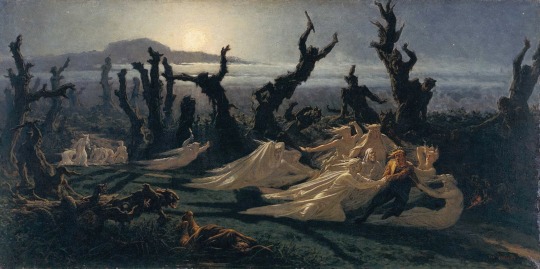
The Washerwomen of the Night (Les Lavandières de la nuit) (Yan' Dargent, c. 1861)
803 notes
·
View notes
Note
Long ask. Bear with me, please.
I'm still thinking about what counts or not as a fairy tale.
To be honest, I think the only pre-requisites for something to become a fairy tale in pop culture is for it to be a popular fantasy children's story in public domain. And kinda look like a fairy tale, too.
In your opinion, which work would be considered a fairy tale if it weren't for copyright?
Let me give, my examples
C.S. Lewis' Narnia books, especially the first one, The Lion, the Witch, and the Wardrobe. If Alice in Wonderland and Wizard of Oz are considered fairy tales, especially in crossovers, Narnia should be too as it shares many themes, plot points, and character archetypes.
Charlie and the Chocolate Factory. It literally uses all fairy tale archetypes and cliches under the sun, even if it ditches magic for extremely soft sci-fi. Willy Wonka is like Frau Holle or that fairy godmother from Toads and Diamonds, the four brat children are like those siblings and step-siblings who are always magically punished, and even as a child I knew Charlie Bucket was Cinderella but with no focus on romance. He's the youngest sibling that always is magically rewarded.
It is quite funny because I had the idea to make a post about this subject specifically! But since you asked I'll drop some elements of my planned posts here - it can be a good introduction!
Now if you ask me, "fairytale" can't be everything and anything, but that's probably because I come from France where "fairytales" are literaly a literary genre first, and then a category of folktales and legend, and we have specific categorizations different from other countries (again, the merveilleux/fantastique divide for example which determines the French approach to supernatural and fantasy, but is absent from English literature if I am not mistaken).
I... personally do not believe any "popular children story" would be a fairytale. Else that would make the first Harry Potter books a fairytale, or the Winnie the Pooh stories a fairytale or Despicable Me or the recent musical Troll movies fairytales. I think the inherent decision to make something "for children" fairytale like is bad because, again, fairytales were not originally meant for children and thus should not be limited to a child audience.
From my point of view, a fairytale needs to be either a folktale that hold itself in a specific format that makes it separate from legends and myths (the type of local folkloric stories told by old storytellers to children in the countryside for example - but with a clear plot, clear characters, and beginning and ends, separating it from vague legends ; and with a minimum religious element, to separate it from myths for example). I do not like to think of Greek myths as "Greek fairytales". For example, to take an example of the folkloric fairytales of France vs the legends: we have in Bretagne the belief in "les lavandières de nuit", "the night washer-women", ghostly, otherwordly apparitions of women washing clothes at night, and you should never help them else you'll end up dead or with your arms broken. If someone simply tells you what I told you above "It is said there are ghostly women who wash linen at night...", this is more of a "legend", like ghost stories, or "Oh, this is a fairy mound haunted by fairies!" or "It is said a monster lives in this cave". But if you actually tell the story of a specific peasant boy with a specific name, who due to specific reasons ends up meeting these women, and either escapes or falls to their fate, we already are closer to the folktale and thus the "fairytale of Bretagne". But this is all obvious, as these kind of fairytale-folktales were those collected by Grimm and Jacobs and Moe and others...
And then you have literary fairytales, which are stories meant to evoke or imitate the folktales described above, and can derive in many ways (be more "literary") but still identify or present themselves or link themselves to these folktales. These are the Perrault and d'Aulnoy and Andersen fairytales for example. This category can be pushed further with what we call in French "contes détournés" - you could call them "fractured fairytales" to take back a common English term, that is to say all the parodies and rewrites and deformations of fairytales, sometimes for humoristic effects, other times not. Modernization and expansion of fairytales are part of that, so to speak. But we stay in a domain where the story is presented or follows the code and format of fairytales, while also explicitely avoiding, pointing out or reversing the common tropes and rules.
But where the Narnia books and the Dahl books enter, we reach a domain that is not fully fairytale but rather a crossroad between three genres deeply intertwined. "Fairy tales" (or rather "modern fairytales") ; "Fairytale-Fantasy" and "Children fantasy".
Children fantasy is basically any modern children story (by modern I mean deliberately fictional and written as fiction) that involves magic and the supernatural. And these stories can be influenced by fairytales, since it is something children are very aware about, but not always. Peter Pan, just like the Oz books, are "children fantasy" - a form of fantasy for children primarily, or rather a form of children stories that step into the fantasy realm. Pinocchio is one of the oldest "children fantasy", as in a work primarily aimed at children, but with magical and fantastical elements in it.
"Fairytale-fantasy" however is a term usually given to a subgenre of fantasy works that, instead of taking inspiration from epic sagas (epic fantasy) or horror works (dark fantasy) or other things ; takes inspiration from fairytales and folktales. The same way Tolkien was the father of "epic fantasy" he was also the father of "fairytale fantasy" through his Hobbit novel, and also other works (his Tom Bombadil poems, his Farmer Gilles of Ham novel).
The thing is that "children fantasy" and "fairytale fantasy" are deeply interconnected since both can draw source from fairytales and folktales to build entirely new stories. As a result there is a frequent overlap. The Oz books belong as much to "children fantasy" (one of the biggest success in terms of magical series of children-book) as "fairytale fantasy" (they were a pure deconstruction of typical fairytales, explicitely playing with fairytale codes, and later becoming an "American fairytale" classic). The Narnia books are also part of this crossroad, as they are "children fantasy" (they are a traditional fantasy story with epic tones, but for children and teenagers), while also being "fairytale fantasy" (taking inspiration and paying homage to several fairytales and folktales). They all belong to this category of works which are not fairytales per se (since they are not of folkloric origins, nor were they meant to be faithful rewrites or perfect pastiches of traditional folkloric fairytales), but definitively works of fiction based upon fairytales, inspired by fairytales, and mant to take fairytales into the "next step" of the world of fiction.
The main difference between "children fantasy" and "fairytale fantasy" would be as such. Children fantasy, while sometimes inspired by fairytales, is not always tied to fairytales and can be completely fairytale free. For example many of Roald Dahl stories do pay homage to fairytales and are inspired by his fairytales (his witches in The Witches, his giants in THE BFG, Wonka and his factory, the Giant Peach, etc...), he is part of the "writers of modern fairytales". But you have also lot of children stories with magic that do not involve any fairytale reference. Children fantasy can be inspired and allied by fairytales, but is not defined by them.
On the opposite side, "fairytale fantasy" is defined by fairytales - but not by age. Yes some of the most famous "fairytale fantasy" works are for children: the Oz books or the Narnia books. But just as many are for adults and definitively not for children. Neil Gaiman wrote a Coraline for children, but his Stardust is definitively for adults. The movie "Legend", while one of the most iconic fairytale-fantasies, is for adults.
So, I think the real way to point out what a fairytale is, is to look at the format and intentions of the author and of the work, to see if it fits the literary fairytales of old. There needs to be a conscious emulation, pastiche or imitation of traditional fairytales, there needs to be something that make it feel like a fairytale, and not like a story inspired by fairytales. But honestly... this is deep down really, really hard to draw a line as it mostly comes to personal definitions and appreciations. The genre of fairytales is vast and blurry, as it covers traditional European folktales and a specific short literary genre first, but was then expanded to cover other literary works and non-European folktales - and so the lines are... muddled.
I do not hesitate to say that "Over the Garden Wall" is actually a modern fairytale, as seeing the show made me literaly feel again the same kind of feeling I had when I first discovered fairytales. But I can understand why people would consider it "fairytale fantasy" rather than a "modern fairytale" because it was made with the intent of it being a children show and fantasy show first and foremost. Dahl stories are definitively "modern fairytales" - but the fact they are set in "modern day" and a grounded reality where the supernatural is not supposed to exist can disqualify them from being traditional fairytales ; or the humor and parody and play with the fairytale codes can also create a distanciating humor that make them fairytale subversions or pastiches or parodies rather than fairytales. Pinocchio has everything that fits a literary fairytale - but its format also evokes old "story-cycles" like the Reynard adventures or Gargantua ones, and its lack of simplicity and uniformity, or rather its long, flowing nature can also disqualify it from being a fairytale and rather make it a fairytale-inspired fantasy....
Honestly the narrowest definition you can have of "fairytale" is: printed works that explicitely designate themselves as such, from collected folktales (Grimm) to literary fiction written to emulate and imitate them (Andersen). This is the most narrow definition you can have. But then, one can expand to include all folktales that inspired fairytales ; or on the other side, one can push into the literary direction, to include stories that do not have the fairytale format, but that were so heavily inspired and shaped after fairytales, and gained such a popular influence and widespread presence, that they became "modern fairytales". But then this also opens the door to questions such as "What is a myth?" or "What about literary myths?" (like Faust or Don Juan or Frankenstein, all those famous "literary myths" as we call them in French).
As you can see by this convoluted answer, it is not a clear-cut question and nobody can truly answer it. Everybody will have a different opinion, and there is no real limit. The question mostly defines in how the work label itself. Perrault and Grimm and Andersen works called themselves fairytales, so there is no doubt about it. But take Neil Gaiman's Stardust - an iconic of fairytale fantasy, and yet Gaiman refers to it as a "romance in Faerie", evoking more the genre of fantastical and supernatural romances (medieval-meaning of the sense) like "The Well at World's End" and others - and the work is also very inspired by fantasy fae stories with a vague proto-urban fantasy feel to it, like "Lug-in-Mist". Same thing with the movie "Legend" which is definitively inspired by fairytales and a fairytale-fantasy, but was sold as a "fantasy movie" or even "heroic fantasy" movie first and foremost. Meanwhile the Oz books were intended by Baum to be a "modern, American fairytale" - even though their novel format and their franchise nature removes the idea they can become as "traditional" as the folktales he meant to imitate...
I'll stop there for now, but long story short: It's complicated, and when in doubt, don't hesitate to refer to intermediary terms like "children fantasy" or "fairytale fantasy", which clearly evoke modern fictional works and can highlight a difference with classic literary fairytales or folkloric fairytales, without rejecting the idea these "modern fairytales" aren't fairytales in their own right.
#question#fairytales#what is a fairytale#fairytale fantasy#children fantasy#literary fairytale#folkloric fairytale#i honestly don't know what i am writing
15 notes
·
View notes
Text

Nous étions assis main dans la main, Le cœur debout et en plein éveil. Ta tête lourde, sur mon blanc sein, Reposait sans trouver le sommeil. Le soir paisible appelait les anges À descendre et cueillir nos soupirs. Avant qu'un froid infernal nous change, Nous observions nos roses fleurir. Chaque baiser plantait un jardin, Nos joues rouges tapissant d'étoiles. Dans tes yeux, je voyais le Destin Semer une goutte de cristal. Rayons de lune, sur nos visages, En arrachaient le voile embrum��. Nous étions, faisant fi des présages, Ce que nous ne serons plus jamais. Car le vent d'hiver a balayé Ailleurs les parfums de notre amour. Ta voix qui autrefois m'égayait N'est plus que l'écho d'un défunt jour. À présent, des spectres encendrés Disent ton nom. Où est la lumière? Même à l’infrarouge, on ne pourrait Mettre le doigt sur la chaleur d’hier. Tu n’es plus que, parmi les fantômes, Un membre, un vaisseau. Où est le sang? Tiède, ne le conduit pas l’homme, Mais le squelette de meilleurs temps. Et moi, fantasme duquel tu fuis, Sans être là, de près je te hante. Comme une lavandière de nuit, Tordant le linge et ton bras, je chante. Comme l’ombre de la Dame Blanche, Je te suis. Mais où sont tes ténèbres? Je me suis pliée comme une branche Vers ton autel d’idole funèbre. -Poésie: extrait de "Nous étions - hommage à l'imparfait", à lire dans "Genèse d'une femme" par Marine Mariposa, disponible gratuitement sur https://sites.google.com/view/papillondusublime/gen%C3%A8se-dune-femme
#poesie#poetry#french literature#winter#winter wonderland#snow#windy day#ghost#lovecore#love#romantic#romance#breakup
2 notes
·
View notes
Text

Yan'Dargent
Les Lavandières de la nuit, 1861
Quimper, musée des beaux-arts
(source)
3 notes
·
View notes
Text

10 juin 1936
Au détour du chemin, Il étendit la main, Devant le beau matin.
Le ciel était si clair Que les nuages dans l’air Ressemblaient à l’écume de la mer.
Et la fleur des pommiers Blanchissait dans les prés Où séchait le linge lavé.
La source qui chantait, Chantait la vie qui passait Au long des prés, au long des haies.
Et la forêt à l’horizon, Où verdissait le gazon, Comme une cloche était pleine de sons.
La vie était si belle, Elle entrait si bien dans ses prunelles Dans son cœur et dans ses oreilles,
Qu’il éclata de rire : Il rit au monde et aux soupirs Du vent dans les arbres en fleur.
Il rit à l’odeur de la terre, Il rit au linge des lavandières, Il rit aux nuages passant dans l’air.
Comme il riait en haut de la colline, Parut la fille de belle mine Qui venait de la maison voisine.
Et la fille rit aussi Et quand son rire s’évanouit Les oiseaux chantaient à nouveau.
Elle rit de le voir rire Et les colombes qui se mirent Dans le bassin aux calmes eaux Écoutèrent son rire Dans l’air s’évanouir.
Jamais plus ils ne se revirent. Elle passa souvent sur le chemin Où l’homme tendit la main À la lumière du matin.
Maintes fois il se souvint d’elle Et sa mémoire trop fidèle Se réflétait dans ses prunelles.
Maintes fois elle se souvint de lui Et dans l’eau profonde du puits C’est son visage qu’elle revit.
Les ans passèrent un à un En palissant comme au matin Les cartes qu’un joueur tient dans sa main.
Tous deux pourrissent dans la terre, Mordus par les vers sincères. La terre emplit leur bouche pour les faire taire.
Peut-être s’appelleraient-ils dans la nuit, Si la mort n’avait horreur du bruit : Le chemin reste et le temps fuit.
Mais chaque jour le beau matin Comme un œuf tombe dans la main Du passant sur le chemin.
Chaque jour le ciel est si clair Que les nuages dans l’air Sont comme l’écume sur la mer.
Morts ! Épaves sombrées dans la terre, Nous ignorons vos misères Chantées par les solitaires.
Nous nageons, nous vivons, Dans l’air pur de chaque saison. La vie est belle et l’air est bon.
Robert Desnos
[Alfred Sisley - Normandie, le sentier au bord de l'eau, soir à Sahurs]
2 notes
·
View notes
Text
These are pictures of les lavandières de nuit, the night washerwomen.

'Breton Legends' illustrated by Maurice de Becque, 1921.
#reblog#illustration#lavandières de nuit#breton folklore#bretagne#maurice de becque#night washerwomen#french things
760 notes
·
View notes
Text
the Aos Sí: Figures of Celtic Fae Lore
by Keziah
‘Aos sí’ is a term used to encompass a complex and powerful array of figures within Irish pagan theology and Celtic mythology, figures I sometimes refer to as the Otherworld Folk and Otherkin. You’ll hear them more commonly called the Sídhe, fairies/faeries/the fae, the Good Neighbors, the Folk, the Good Folk, daoine sídhe/daoine sìthe. There are no doubt countless terms and names used to mean the aos sí, and just as many theories as to who these figures are, where they come from, and what they do.
One of the most prevalent beliefs, which is mentioned in many Irish legends, is that the aos sí are (or are related to) the Tuatha dé Danann. Others have likened the aos sí to elves and faeries. In my opinion, it’s impossible to sum up who/what the aos sí are as the term could be applied to every kind of Otherworldly spirit and figure within the Celtic realm. I won’t be able to go over all of them within this piece (just for the sake of time), but I’ll do my best to go over a fair few of them.
What Does Aos Sí Mean?
The Irish term ‘aos sí’ (which is pronounced as aes [the ae sounding like a somewhat softer version of the ay in ‘way’] shee) means ‘the people from/of the mounds.’ These figures are more commonly referred to as sídhe nowadays, though sídhe/sí (sìth in Scots Gaelic) was once exclusively used to mean the burial mounds, tombs, and other such areas linked to the Otherworld that these figures were believed to reside beneath or within. The word has now come to bear two meanings, and its far better-known use is in reference to the figures themselves rather than the mounds with which they’re associated.
What Figures Are Classified as Aos Sí?
Bean Sídhe - Banshee
The term bean-sídhe (bean-sìth or ban-sìth in Scots Gaelic) means ‘faerie woman’ or ‘sídhe woman’ and therefore could (and once did) refer to any woman that hailed from the Otherworld. However, it’s now applied specifically to a spirit who heralds a forthcoming death, traditionally by way of blood-chilling wailing and moaning.
The banshee is usually described as having the appearance of either a withered hag or young woman of incomparable beauty. The former depiction has become the most recognized nowadays. The banshee is said to dress in either a white, gray, or black flowing robe or cloak and has a very pale white complexion with redness around the eyes from weeping so much. They’re usually described as having either heaps of black or fiery red hair. Some depictions tell of the banshee standing at an ‘inhumanly’ or ‘unnaturally’ tall height, others describe them as being of average human height, and still others portray the banshee as being short. On that, the Lady Wilde says in ‘Ancient Legends, Mystic Charms, and Superstitions of Ireland’ –
‘Though some accounts of her standing unnaturally tall are recorded, the majority of tales that describe her height state the banshee’s stature as short, anywhere between one foot and four feet. Her exceptional shortness often goes alongside the description of her as an old woman, though it may also be intended to emphasize her state as a fairy creature.’
In ‘the Memoirs of Ann, Lady Fanshawe’ an encounter that Lady Fanshawe had with a banshee is described –
‘There we stayed three nights, the first of which I was surprised at being laid in a chamber where, about one o’clock, I heard a voice that awaked me. I drew the curtain, and in the casement of the window I saw by the light of the moon a woman leaning into the window through the casement, in white, with red hair and ghastly complexion. She spake loud, and in a tone I never heard, thrice, “Ahone”; and then with a sigh more like wind than breath she vanishes, and to me her body looked more like a thick cloud than substance.’
Bean-Nighe - Washer at the Ford

'Les Lavandières de la Nuit' by Yan' Dargent; 1861
Bean-nighe is Scots Gaelic for ‘washerwoman’ and is used to describe a female wraith spirit or figure, often seen as a type of ban-sìth. In French lore, they’re known as les Lavandières (‘the Midnight Washerwomen’). She is another oracle of death, said to appear at the waterside of streams, rivers, or lakes to wash the bloodstained clothes of those soon to meet life’s end.
She is often described as being thin and frail-looking, dressed in green. Some lore states that she has webbed toes and red feet. Many believe the Washerwoman also has the power to impart great wisdom and secret knowledge to people, as well as the power to grant wishes if one dares to approach her and does so cautiously. However, others believe that approaching the Washerwoman and interrupting her work will result in her cursing you or injuring you by hitting you with her washing, which is said to strike so hard it can even break one’s bones. Some Irish and Scottish lore states that if you saw the Washerwoman before she saw you, you could ask her to foretell your future, as they have the gift of prophecy.
Though the bean-nighe are usually accepted as spirits and members of the Fae Folk, there are some other beliefs as to the origin of the Washerwomen. One such belief is that this is what becomes of the spirit of women who die prematurely during childbirth. Others say that to avoid becoming a bean-nighe after death, a woman must make sure that all her clothes have been washed and there was no dirty laundry left behind.
Most commonly the bean-nighe is associated with foretelling the deaths of warriors before battle, as she is apparently most often sighted at such times and with heaps of washing to do.
Dúlachán
The Irish dúlachán, dubhlachan, or dullahan, meaning 'the dark man,' is a male figure within the Fae Folk, a headless horseman whose steed is black as night. Some tales say he carries his head, face fixed with a horrifying grin, in his hand and some stories depict both the dúlachán and his steed as being headless. Other stories say he does not ride on horseback but drives the Death Coach – a black coach drawn by black horses (sometimes said to be headless themselves) that would go to collect the dead and take them from this realm to the Otherworld.

from Thomas Mayne Reid's 'the Headless Horseman;' 1865.
The dúlachán is said to use a whip made of bone, often described to be of human spine, and his clothes or cloak (or the covering of his coach bench in the version in which he drives the Death Coach) is allegedly made from human flesh.
It is said that the dúlachán riding by was a portend of one’s impending end; and sightings of the Death Coach are believed to foretell death. It is also believed that if the dúlachán utters someone’s name, they instantly die.
Ghillie Dubh
Ghillie Dubh or Ghillie Du is a figure from Scottish Highlands folklore, a faerie man believed to live (or to have lived) in a birch wood in the Northwest Highlands of Scotland, within the area of Gairloch and Loch a Druing, where he is said to have been spotted in the latter part of the 18th century.
He is described as being of small stature, having messy dark hair, and wearing clothes of moss, leaves and grass. It’s generally said that he was quiet, good-natured, and gentle. One tale states that he rescued a local child that had wandered into the woods and gotten lost, took care of the child for the night, and escorted her safely home the next morning. Many who lived in the area claimed to have seen Ghillie Dubh.
Unfortunately, Ghillie Dubh has not been spotted since shortly after he rescued the local child, when the laird, Sir Hector Mackenzie of Gairloch, invited a group of hunters to track and shoot kind-hearted Ghillie Dubh. As the tale goes, though the group searched all night, they never found Ghillie Dubh, and Ghillie Dubh was never seen in the area again.
Clúrachán
A relative of the leprechaun, the clurichaun (or clúrachán) is a solitary member of the Fae Folk known for his love of the drink. He’s said to steal from wine cellars, taverns, pubs, and breweries and is particularly hard to rid from such establishments. Even if the owner of such a place moved locations, the clurichaun could simply hide away in a barrel cask and go along for the ride.
They’re said to wear red clothes and fine shoes, and to carry a magical purse or pouch. Some tales say that the purse never runs out of money and will always be full. Other stories say that the purse contains a single shilling that will always return to the purse no matter how or where it was spent. They’re also said to be guardians of hidden treasure.

from T.C. Croker's 'Fairy Legends and Traditions of the South of Ireland;' 1825-1828
Such a figure has many names – the Cluricaune in County Cork, the Lugirgadaune in Tipperary, the Loughery Man in Ulster, and the Lurichaun or Luricaune in County Kerry.
Fear Dearg
The fear/fir dearg or far darrig (meaning ‘Red Man’ in Irish) is another faerie figure. These characters, sometimes called Rat Boys are most commonly described as being portly and hairy-skinned and having skinny tails and long snouts, like those of rats. Their preferred pastime is making mischief and pranking, though their idea of pranking is what mankind would see as horribly cruel, such as stealing babies and leaving changelings in their place.
Alp-Luachra - the Joint-Eater
The alp-luachra is a type of water sprite. Some lore describes it as being difficult to see or invisible, while other tales say that it could transform itself into a small newt and could be consumed when drinking water from a stream or spring. They would also wait for one to fall asleep beside such a water source, turn themselves into a newt, and then crawl stealthily into the mouth of the sleeping person.
If the alp-luachra was ingested one would suffer terrible stomach aches, hunger, and intestinal ailments, and they cannot put on weight.
To rid oneself of an alp-luachra, it is said one must eat an abundance of very salty food and take no water to wash it down or quench the thirst it will deliver. Some lore says that the alp-luachra will then fling itself from the sufferer’s body via the mouth. Other tales say that you must first lay down to sleep by a spring or stream. The alp-luachra will then crawl free from your mouth whilst you slumber. Otherwise, it will die of thirst in your body.
Cait-Sìth – the Faerie Cat
The Scottish cait-sìth or cat-sìth means ‘faerie cat’ and refers to a spectral figure that haunts the Scottish Highlands. It’s said to resemble a very large black cat with a white spot on its chest. Their size is said to be so big that they can be mistaken as being a large breed of dog.
It’s believed that when you spot a cait-sìth, it will arch its back and its hair will stand upright. It may also hiss or let out a low yowl. If that behavior isn’t enough to tell you to keep your distance, let this be – it is said that the cait-sìth has the power to take one’s soul. In fact, the belief that it is unlucky for a cat to pass over a corpse or recently filled grave is linked to the cait-sìth. In the Highlands, it was thought said cat may have been a cait-sìth in disguise, come to try and steal the soul of the deceased before any god could lay their claim.
It is also believed that the cait-sìth has the power to curse you and will do so if on Samhuinn night you do not leave a saucer of milk out for them as an offering. If you do, they’re said to bestow blessings upon the household.
While the name leads one to include this figure as being of the Fae Folk, there is some lore that states otherwise, saying that this spirit is actually a witch transfigured into the form of a cat.
Cù-Sìth – the Faerie Hound
The cù-sìth (Scots-Gaelic) or cú sídhe (Irish) is a faerie hound or Otherworldly hound. In Ireland, it’s said to dwell in cliffy, mountainous areas, where it can be found having made a den in the clefts of the rocks. In Scotland, they can be spotted in the Highland moors.
They’re described as being able to move in absolute silence, which aids them in hunting, something they’re said to be quite good at. When they do bark, they bark three times and the barks are exceptionally loud, so loud that they can be heard from miles and miles away. Those who hear the barks must reach safety by the third bark, else they will die of fear.
The cù-sìth is said to have a shaggy coat of fur, which is often described as being dark green in color, and they, like the cait-sìth, are much larger than their counterparts of our own realm. The cù-sìth has been described as being as big as a cow.
Ci Annwn
The above mentioned cù-sìth is not unlike the Welsh Ci Annwn (‘Hound of Annwn’). Annwn is the Welsh Otherworld, ruled over first by Arawn and later by Gwyn ap Nudd, the King of the Fair Folk.
The Ci Annwn (Cŵn Annwn when pluralized) is a huge, white spectral hound with red ears and is believed to be a portend of death. It’s said to see one, especially to see one headed your way, means that death is to come.
These dogs are said to hunt near and on the mountain Cader Idris/Cadair Idris in County Meirionnydd. If you’re in that area and you hear the howling of Annwn’s hounds, your death has been foretold.
the Tuatha dé Danann
Many people count the Tuatha dé Danann as a whole among the aos sí, some see specific members of the Tuatha dé Danann as befitting of the modern understanding and use of the term the Sídhe, and others would describe the Tuatha dé Danann as the forefathers of the aos sí, seeing the aos sí as descendants of this mighty tribe. There is so very much that we could explore with the Tuatha dé Danann, their ascendancy to power and their reign over Ireland, their rivals, their many deeds and adventures, but I promise I will write a separate piece dedicated to a more thorough look at the Tuath Dé. For this blog, I’m going to try and keep it short and sweet and give a general explanation and idea of who they are.
Tuatha dé Danann means ‘the People of Danu’ or ‘the Tribe of the Goddess Danu’ – Danu being an Irish ancestral goddess sometimes depicted as an earth goddess and sometimes associated with the goddess Anu. The Tuatha dé Danann are an incredibly powerful Irish tribe of deities. They’re also called the Tuath Dé, meaning ‘the Tribe of Gods’. Most commonly, they’re seen as gods and goddesses. Some, though, think them spirits, and others see them as mythological representations of ancient kings and queens of Ireland.
According to the Lebor Gabála Érenn, the Tuatha dé Danann came to Ireland in dark clouds that moved over the land and descended upon Sliabh an Iarainn in Connacht. The ‘dark clouds’ are interpreted as describing the clouds of smoke that billowed up from the ships that the Tuatha dé Danann traveled to Ireland in, ships which, according to legend, the tribe set aflame in order to prevent themselves from being tempted to leave this land they had newly come to. Eventually they ascended to rule over Ireland, a reign that met its end after a lengthy conflict with the Milesians (who are often interpreted to represent the Celts, the Irish people, and the Christianization of Ireland or the establishment of a ‘post-pagan’ idea of Ireland).
The Tuatha dé Danann are said to now reside within and rule over the Otherworld, their agreed upon place of dwelling in the terms laid out in a treaty with the Milesians. The Tuath Dé are still known, however, to walk among the living and influence the lives and affairs of those within our own realm.
While I would love to describe and explore the individual members of the Tuatha dé Danann, I don’t want this section to become incredibly long and painfully out of balance with the rest of this piece. I’ll instead touch on a few figures perhaps most heavily associated with the Fae Folk or with the more modern understanding of the Sídhe.
Clíodhna
Heroine, goddess, and faerie queen.
Said to be the most beautiful woman in the world.
Goddess of beauty and love; patron goddess of County Cork.
Goddess of sovereignty in Munster.
Reigns as queen over all the faerie women of South Munster.
Has three birds whose magical songs have healing powers.
Served as banshee (foretelling the deaths of the members of the house and clan) to the MacCarthys.
Was the faerie lover of Ciabhán, John Fitzjames, Earl Gerald Fitzgerald, and Caomh.
Also called Clídna the Fair, Queen of the Banshees, the Faerie Queen, the Faerie Queen of Munster.
Badb
Ancient shape-shifting goddess, death-bringer, and war fury.
Goddess of war, battle, madness, death, and prophecy.
Associated with banshees.
Associated with the cry and song of crows.
Also called Badb Catha (‘the Battle Crow’).
Macha
Goddess of sovereignty of Ireland (particularly within Ulster), thus associated with the land, fertility, guardianship, and the selecting of kings.
Associated with horses.
Sometimes described as a goddess of war and battle.
Associated with warriors on horse-back or warriors who used chariots.
Considered a ‘faerie lover’ or ‘faerie wife’ in her tale with the farmer Cruinniuc.
Mór-Ríoghain or the Morrígan
One of the best-known and most revered (and feared) Irish goddesses.
A shape-shifting goddess of war, battle, death, victory, and fate.
She’s also seen as a goddess of magic and an oracle, and many magical practitioners devote themselves to the Morrígan or seek her matronage in their work.
Also called the Phantom Queen, the Death Queen, and the Great Queen.
Note: There is some debate surrounding the figures of Badb, Macha, and Mór-Ríoghain, which have been called as a collective trio the Three Mórrígna. Some see each as an individual goddess on her own, though related to one another as sisters. Then there are those who see the goddesses as being three sides of one goddess, an idea that has been popularized especially within Celtic Neopagan, Wiccan, and Neo-Druidic schools of thought.
Sources and Further Reading: ‘Ancient Legends, Mystic Charms, and Superstitions of Ireland’ – Wilde, Lady Jane ‘Beside the Fire: A Collection of Irish Gaelic Folk Stories’ – Hyde, Douglas ‘Encyclopedia of Celtic Mythology and Folklore’ – Monaghan, Patricia ‘the Great Queens: Irish Goddesses from the Morrígan to Cathleen Ní Houlihan’ – Clark, Rosalind ‘Gods and Fighting Men: the Story of the Tuatha De Danann and of the Fianna of Ireland’ – Gregory, Lady Augusta the Irish Pagan School – www.irishpaganschool.com ‘Lebor Gabála Érenn: the Book of the Taking of Ireland’ -MacAlister, R.A. Stewart Lora O’Brien – www.loraobrien.ie ‘the Memoirs of Ann, Lady Fanshawe’ – Fanshawe, Herbert Charles
#irish mythology#celtic mythology#sheydmade mythology#scottish mythology#aos sí#bean-sídhe#fae folk#sidhe#Bean-nighe#les Lavandières#dullahan#ghillie du#clúrachán#fear dearg#alp-luachra#cait-sìth#cù-sìth#Ci Annwn#Cŵn Annwn#welsh mythology#tuatha de danann#sheymade-themorrigan#sheydmade-cliodhna#sheydmade-badb#sheydmade-macha
2 notes
·
View notes
Text
KATHERINE LA DENTELLIÈRE
FILLE AMOUREUSE
Elle naquit vers le milieu du quinzième siècle, dans la rue de la Parcheminerie, près de la rue Saint-Jacques, par un hiver où il fit si froid que les loups coururent à travers Paris sur les neiges. Une vieille femme, qui avait le nez rouge sous son chaperon, la recueillit et l’éleva. Et premièrement elle joua sous les porches avec Perrenette, Guillemette, Ysabeau et Jehanneton, qui portaient de petites cottes et trempaient leurs menottes rougies dans les ruisseaux pour attraper des morceaux de glace. Elles regardaient aussi ceux qui pipaient les passants au jeu de tables qu’on appelle Saint-Merry. Et sous les auvents, elles guettaient les tripes dans leurs baquets, et les longues saucisses ballottantes, et les gros crochets de fer où les bouchers suspendent les quartiers de viande. Près de Saint-Benoît le Bétourné, où sont les écritoires, elles écoutaient grincer les plumes, et soufflaient la chandelle au nez des clercs, le soir, par les lucarnes des boutiques. Au Petit-Pont, elles narguaient les harengères et s’enfuyaient vite vers la place Maubert, se cachaient dans les angles de la rue des Trois-Portes ; puis, assises sur la margelle de la fontaine, elles jacassaient jusqu’à la brume de la nuit.
Ainsi se passa la prime jeunesse de Katherine, avant que la vieille femme lui eût appris à s’asseoir devant un coussinet à dentelles et à entrecroiser patiemment les fils de toutes les bobines. Plus tard, elle ouvragea de son métier, Jehanneton étant devenue chaperonnière, Perrenette lavandière, et Ysabeau gantière, et Guillemette, la plus heureuse, saucissière, ayant un petit visage cramoisi qui reluisait comme s’il eût été frotté avec du sang frais de porc. Pour ceux qui avaient joué à Saint-Merry, ils commençaient déjà d’autres entreprises ; certains étudiaient sur la montagne Sainte-Geneviève, et d’autres battaient les cartes au Trou-Perrette, et d’autres choquaient les brocs de vin d’Aunis à la Pomme de Pin et d’autres se querellaient à l’hôtel de la Grosse Margot, et sur l’heure de midi, on les voyait, à l’entrée de la taverne, dans la rue aux Fèves, et sur l’heure de minuit, ils sortaient par la porte de la rue aux Juifs. Pour Katherine, elle entrelaçait les fils de sa dentelle, et les soirs d’été elle prenait le serein sur le banc de l’église, où il était permis de rire et de babiller.
Katherine portait une chemisette écrue et un surcot de couleur verte ; elle était tout affolée d’atours, ne haïssant rien tant que le bourrelet qui marque les filles lorsqu’elles ne sont point de noble lignée. Elle aimait pareillement les testons, les blancs, et surtout les écus d’or. C’est ce qui fit qu’elle s’accointa à Casin Cholet, sergent à verge au Châtelet ; sous ombre de son office, il gagnait mal de la monnaie. Souvent elle soupa en sa compagnie à l’hôtellerie de la Mule, en face de l’église des Mathurins ; et, après souper, Casin Cholet allait prendre des poules sur l’envers des fossés de Paris. Il les rapportait sous son grand tabart, et les vendait très bien à la Machecroue, veuve d’Arnoul, belle marchande de volaille à la porte du Petit-Châtelet.
Et sitôt Katherine cessa son métier de dentellière : car la vieille femme au nez rouge pourrissait au charnier des Innocents. Casin Cholet trouva pour son amie une petite chambre basse, près des Trois-Pucelles, et là il venait la voir sur la tarde. Il ne lui défendait pas de se montrer à la fenêtre, avec les yeux noircis au charbon, les joues enduites de blanc de plomb ; et tous les pots, tasses et assiettes à fruits où Katherine offrait à boire et à manger à tous ceux qui payaient bien, furent volés à la Chaire, ou aux Cygnes, ou à l’hôtel du Plat-d’Étain. Casin Cholet disparut un jour qu’il avait mis en gage la robe et le demi-ceinct de Katherine aux Trois-Lavandières. Ses amis dirent à la dentellière qu’il avait été battu au cul d’une charrette et chassé de Paris, sur l’ordre du prévôt, par la porte Baudoyer. Elle ne le revit jamais ; et seule, n’ayant plus le cœur à gagner d’argent, devint fille amoureuse, demeurant partout.
Premièrement, elle attendit aux portes d’hôtelleries ; et ceux qui la connaissaient l’emmenaient derrière les murs, sous le Châtelet, ou contre le collège de Navarre ; puis, quand il fit trop froid, une vieille complaisante la fit entrer aux étuves, où la maîtresse lui donna l’abri. Elle y vécut dans une chambre de pierre, jonchée de roseaux verts. On lui laissa son nom de Katherine la Dentellière, quoiqu’elle n’y fît point de la dentelle. Parfois on lui donnait liberté de se promener par les rues, à condition qu’elle rentrât à l’heure où les gens ont coutume d’aller aux étuves. Et Katherine errait devant les boutiques de la gantière et de la chaperonnière, et maintes fois elle demeura longtemps à envier le visage sanguin de la saucissière, qui riait parmi ses viandes de porc. Ensuite elle retournait aux étuves, que la maîtresse éclairait au crépuscule avec des chandelles qui brûlaient rouge et fondaient pesamment derrière les vitres noires.
Enfin Katherine se lassa de vivre close dans une chambre carrée ; elle s’enfuit sur les routes. Et, dès lors, elle ne fut plus Parisienne, ni dentellière ; mais semblable à celles qui hantent à l’entour des villes de France, assises sur les pierres des cimetières, pour donner du plaisir à ceux qui passent. Ces fillettes n’ont point d’autre nom que le nom qui convient à leur figure, et Katherine eut le nom de Museau. Elle marchait par les prés, et le soir, elle épiait sur le bord des chemins, et on voyait sa moue blanche entre les mûriers des haies. Museau apprit à supporter la peur nocturne au milieu des morts, quand ses pieds grelottaient en frôlant les tombes. Plus de testons, plus de blancs, plus d’écus d’or ; elle vivait pauvrement de pain et de fromage, et de son écuellée d’eau. Elle eut des amis malheureux qui lui chuchotaient de loin : « Museau ! Museau ! » et elle les aima.
La plus grande tristesse était d’ouïr les cloches des églises et des chapelles ; car Museau se souvenait des nuits de juin où elle s’était assise, en cotte verte, sur les bancs des porches saints. C’était au temps où elle enviait les atours des demoiselles ; il ne lui restait maintenant ni bourrelet, ni chaperon. Tête nue, elle attendait son pain, appuyée à une dalle rude. Et elle regrettait les chandelles rouges des étuves parmi la nuit du cimetière, et les roseaux verts de la chambre carrée au lieu de la boue grasse où s’enfonçaient ses pieds.
Une nuit, un ruffian qui contrefaisait l’homme de guerre, coupa la gorge de Museau pour lui prendre sa ceinture. Mais il n’y trouva pas de bourse.
1 note
·
View note
Text

Les Laveuses de nuit, Maurice Sand, illustration for Légendes rustiques by George Sand, 1858
Les Laveuses de nuit, also known as Les Lavandières or Annard Noz are female specters having the appearance of women busy beating their laundry along rivers at night. Sand reports that they are seen as the souls of mothers who have killed their infants, condemned to wash their clothes until the end of time. Anyone who sees them and observes them too closely or disturbs them is in great danger of being caught, beaten and twisted to death along with their laundry.
#légendes rustiques#george sand#maurice sand#les laveuses#les lavandières#annard noz#les laveuses de nuit
14 notes
·
View notes
Photo

Les Lavandières de la nuit, 1888, huile sur toile, Yan D’Argent, Musée des Beaux-arts de Quimper
5 notes
·
View notes
Text
The “Washerwoman” folklore motif in Europe
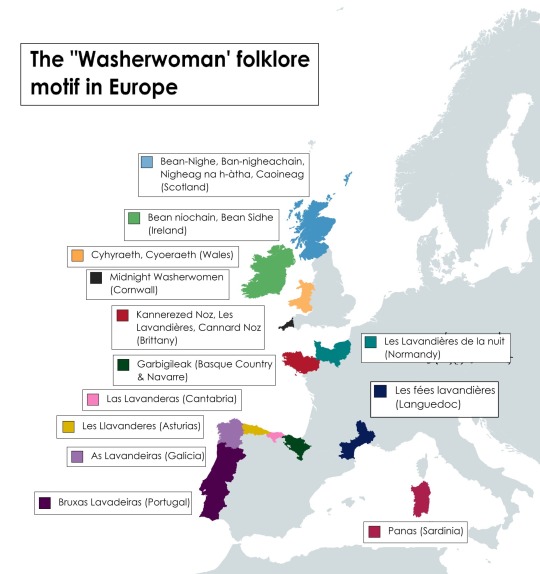
The Lavanderas, or Washerwomen, are three laundresses in the folklore of many regions of Europe. They are said to predict the deaths of people, thus being an omen or portent of death.
They go to the water's edge at midnight to wash shrouds for those about to die.
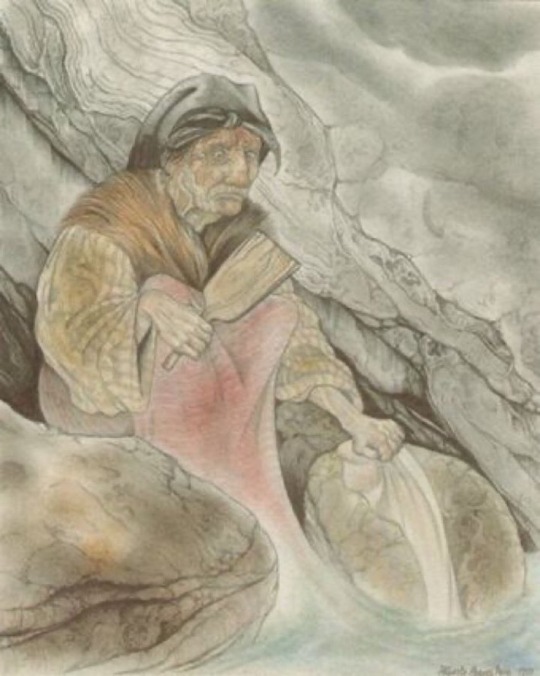
In the folklore of Iberia they are known as the Lavanderas, Lavandeiras, Garbigileak, and Llavanderes depending on the region.
They are old women who frequent rivers and fountains, where they work with a hypnotic and tireless gesture, inviting those who pass by to help them.
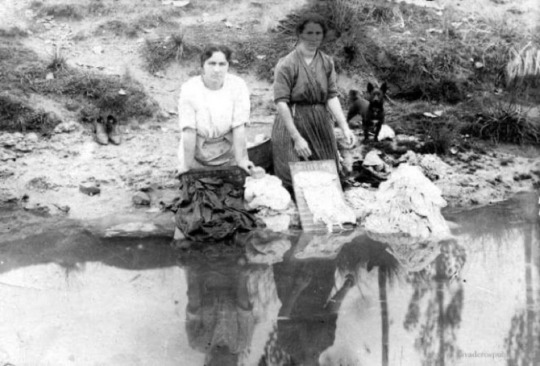
In Iberian folklore, there are two ways to deal with them once seen.
The first, is simply to keep walking, to pass by without saying a word to them, ignoring their pleas.
The other is agreeing to help without complaints, and to twist the clothes in the opposite way as they do.
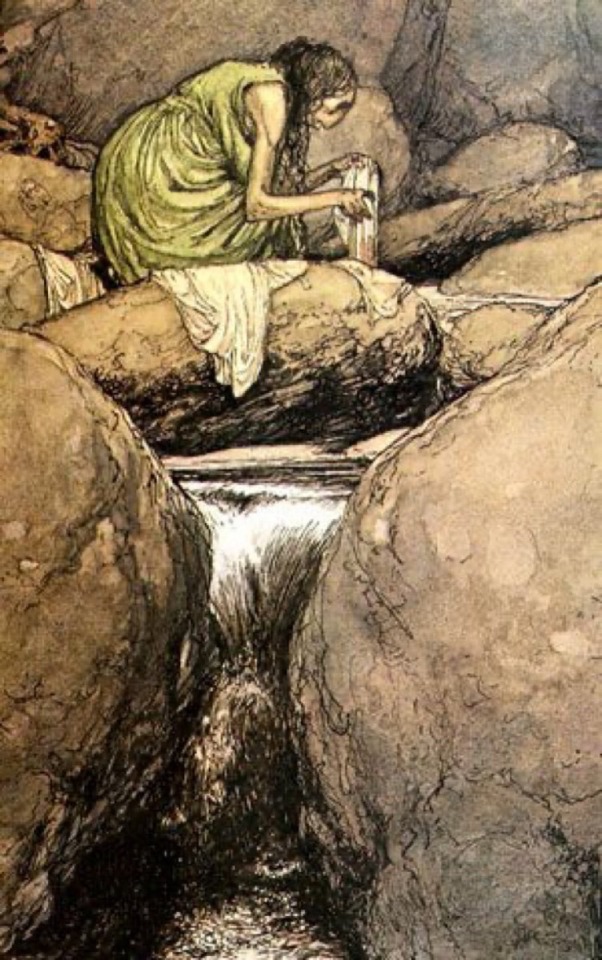
Other names for the Washerwomen in various Celtic languages include the kannerezed noz in Brittany & the Bean nighe in Scottish.
The three old women go to the water's edge at midnight to wash the bloodstained clothing of those who are about to die, according to Celtic folklore
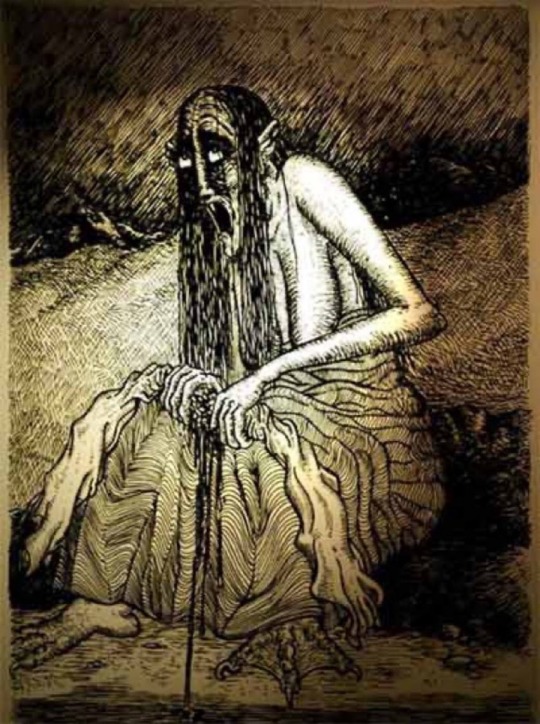
In Wales and Cornwall a passerby must avoid being seen by the washerwomen.
In Ireland, they are an ominous portent, foretelling death, either one's own or a death in the family.
In Scotland, if one can get between the washerwomen & water, they are required to grant three wishes
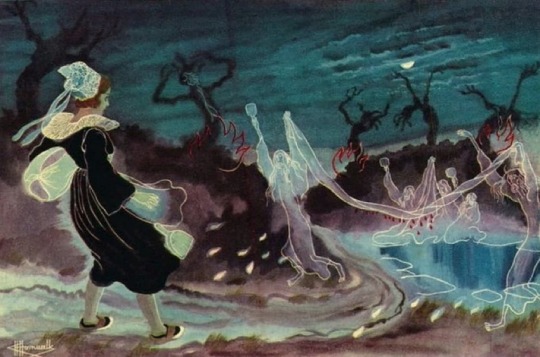
Brittany & Normandy have the lavandière de la nuit.
They can be an ominous portent, foretelling death. They have very pale skin and are often dressed in white.
They wash graveclothes, usually at night, under the moonlight, and have an intense dislike of being disturbed.
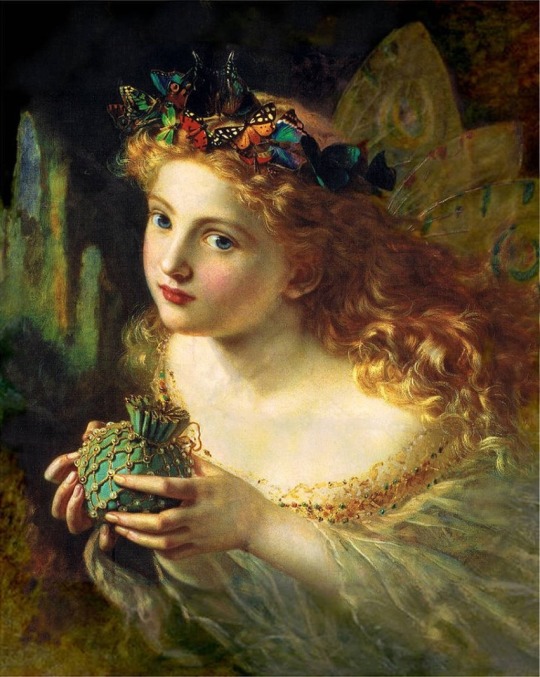
Selon les légendes des Corbières occidentales en Languedoc, les fées lavandières peuplent les grottes et les endroits ténébreux, sortent la nuit et vont laver leur linge avec des battoirs d'or dans le Lauquet (rivière affluent de l'Aude) ou les ruisseaux voisins.
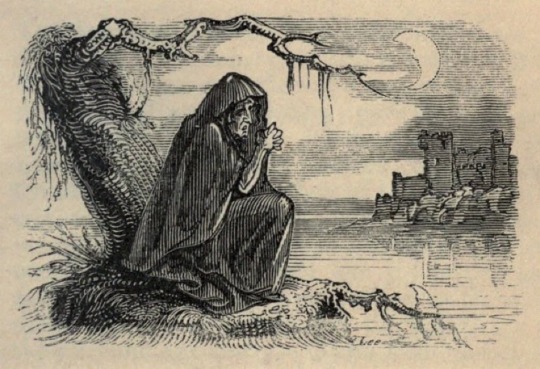
Spiorad baineann i mbéaloideas na hÉireann is ea banshee a fhógraíonn bás duine den teaghlach, de ghnáth trí caoineadh nó ag screadaíl. Tá gruaig fhada shruthlaithe aici, agus tá a súile dearg ó caoineadh leanúnach. Is gnách go dtaispeánann siad in aice le coirp uisce.
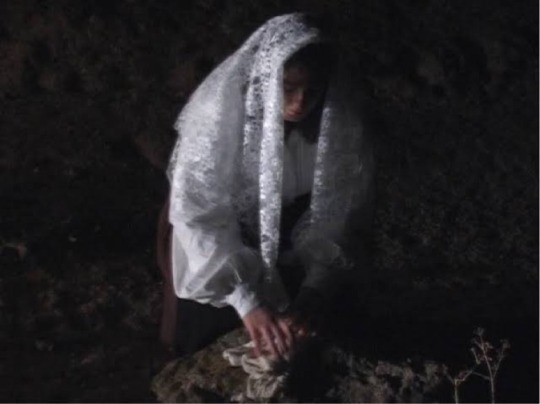
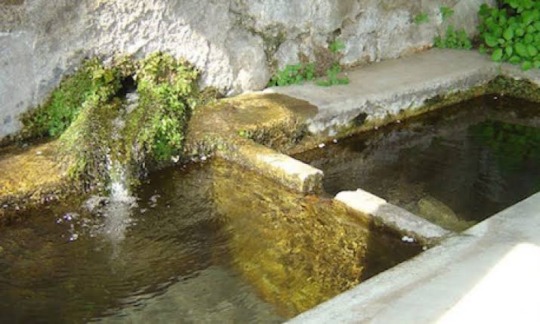
I Panas sono gli spiriti delle donne morte di parto. Sono tornati nel mondo mortale e hanno l'aspetto di essere vivi. Lavano i vestiti dei loro bambini. È possibile trovare panas vicino a fiumi e torrenti che si trovano vicino agli incroci. Cantano ninne nanne tristi.
1K notes
·
View notes
Photo

Jean-Édouard Dargent (French, 1824-1899) , "Les Lavandières de la nuit" ("The Washerwomen of the Night"), c.1861
108 notes
·
View notes
Photo

Yan' Dargent -- “Les Lavandières de la nuit”, 1861
28 notes
·
View notes
Photo

1 note
·
View note
Photo

"This painting by Fernand Le Quesne is an academic (and Parisian) version of the Brittanic folkloric story Les Lavandières de la Nuit or The Washerwomen of the Night. Whereas, in the painting by Dargent (ca. 1861), the spectral women are depicted as clothed and ghoulish, here they are naked and comely - luring the lone bagpiper to a watery and not entirely unpleasant grave."
76 notes
·
View notes